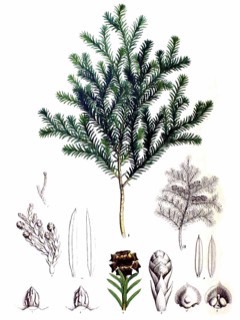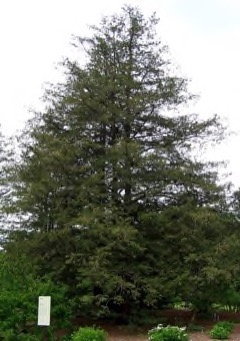 |
|
|
 |
| Bruce Marlin wikimedia.org |
Translate this page:
Summary
Physical Characteristics

 Chamaecyparis pisifera is an evergreen Tree growing to 40 m (131ft) by 25 m (82ft) at a medium rate.
Chamaecyparis pisifera is an evergreen Tree growing to 40 m (131ft) by 25 m (82ft) at a medium rate.
See above for USDA hardiness. It is hardy to UK zone 5. The flowers are pollinated by Wind.
It is noted for attracting wildlife.
Suitable for: light (sandy), medium (loamy) and heavy (clay) soils and prefers well-drained soil. Suitable pH: mildly acid, neutral and basic (mildly alkaline) soils. It can grow in semi-shade (light woodland) or no shade. It prefers moist soil and can tolerate drought. It cannot tolerate atmospheric pollution.
UK Hardiness Map
US Hardiness Map
Synonyms
C. pisifera f. aurea (Gordon) Rehder. C. f. plumosa (Carriere) Beissner. C. pisifera f. squarrosa (Zucc.) Beissner. C. pisifera var. filifera-aurea (Beissner) Rehder. Cupressus pisifera K Koch. Retinispora pisifera Siebold & Zucc.
Plant Habitats
Edible Uses
References More on Edible Uses
Medicinal Uses
Plants For A Future can not take any responsibility for any adverse effects from the use of plants. Always seek advice from a professional before using a plant medicinally.
None Known
References More on Medicinal Uses
The Bookshop: Edible Plant Books
Our Latest books on Perennial Plants For Food Forests and Permaculture Gardens in paperback or digital formats.

Edible Tropical Plants
Food Forest Plants for Hotter Conditions: 250+ Plants For Tropical Food Forests & Permaculture Gardens.
More

Edible Temperate Plants
Plants for Your Food Forest: 500 Plants for Temperate Food Forests & Permaculture Gardens.
More

More Books
PFAF have eight books available in paperback and digital formats. Browse the shop for more information.
Shop Now
Other Uses
Agroforestry: Boundary, barrier or support. Pioneer. General: Ornamental tree. Limited as a source of timber, but widely cultivated as an ornamental, with many named cultivars. As of other members of the genus, the wood is valued in Japan for traditional construction work, but its relative scarcity and the often poor shape of layering trees limit its commercial use [1-7]. Wood Products: Containers including boxes, cases and cooperage. Furniture. Sawn or hewn building timbers. Beams For heavy and light construction. Shingles. Veneers. Musical instruments [1-7]. Good pioneer species with durable wood. Species and large growing cultivars for lawn specimen, shrub borders and screen. Dwarf cultivars for rock gardens, foundation plantings or specimen.
Special Uses
References More on Other Uses
Cultivation details
Average, medium moisture, well-drained soils in full sun to part shade. Best in part shade. Prefers moist, fertile soils. Avoid wet, poorly-drained soils. Shelter from strong winds. Pruning is rarely needed. Winter Interest. Tolerates drought. Good pioneer species with durable wood. A number of varieties exist including: Chamaecyparis pisifera form. crassa Hayashi. Chamaecyparis pisifera form. intermedia Hornib. Chamaecyparis pisifera var. filifera Beiss. et Hochst. Chamaecyparis Chamaecyparis pisifera var. plumosa form. argenta Beiss. Chamaecyparis pisifera var. plumosa form. aurea Beiss. Chamaecyparis pisifera var. squarrosa form. leptoc Sieb. A large number of more compact cultivars including some dwarfs are available.
References Carbon Farming Information and Carbon Sequestration Information
Temperature Converter
Type a value in the Celsius field to convert the value to Fahrenheit:
Fahrenheit:
The PFAF Bookshop
Plants For A Future have a number of books available in paperback and digital form. Book titles include Edible Plants, Edible Perennials, Edible Trees,Edible Shrubs, Woodland Gardening, and Temperate Food Forest Plants. Our new book is Food Forest Plants For Hotter Conditions (Tropical and Sub-Tropical).
Shop Now
Plant Propagation
Seed - sow March/April in a seedbed outdoors[78]. The seed is best sown in pots in a frame[K]. Seed can take 18 months to germinate. One month warm then one month cold stratification has produced good results[113]. When large enough to handle, prick the seedlings out into individual pots and grow them on in a cold frame for their first winter, planting them out in late spring after the last expected frosts. Cuttings in late summer or autumn in sandy soil in a cold frame[1, 11, 200]. Difficult, it may be best done in late winter to early spring[113].
Other Names
If available other names are mentioned here
Pea-fruited false cypress; sawara cypress. French: cypr?s ? fruit de pois; cypr?s de sawara; pisif?re faux cypr?s.Local Common Names: Germany: erbsenfruchtige Lebensbaum; erbsenfruechtige Lebensbaumzypresse; erbsenfruechtige Weisszeder; Sawara- Scheinzypresse. Italy: cipresso giapponese; sawara cipresso. Japan: Sawara. Netherlands: Japanse cypres. UK: Sawara ceder.
Native Range
TEMPERATE ASIA: Japan (Honshu, Kyushu)
Weed Potential
Right plant wrong place. We are currently updating this section.
Please note that a plant may be invasive in one area but may not in your area so it's worth checking.
None Known
Conservation Status
IUCN Red List of Threatened Plants Status : Least Concern ver 3.1

| Related Plants
|
| Latin Name | Common Name | Habit | Height | Hardiness | Growth | Soil | Shade | Moisture | Edible | Medicinal | Other |
| Chamaecyparis lawsoniana | Lawson Cypress, Port orford cedar, Oregon Cedar, Port Orford Cedar, Lawson's Cypress | Tree | 25.0 |
5-7
| M | LMH | SN | DM | 0 | 1 | 3 |
| Chamaecyparis nootkatensis | Nootka Cypress, Nootka Cypress, Yellow Cypress, Alaska Cedar | Tree | 15.0 |
4-8
| M | LMH | SN | DM | 0 | 1 | 3 |
| Chamaecyparis obtusa | Japanese cypress | Tree | 40.0 |
4-8
| M | LMH | N | M | 0 | 0 | 3 |
| Chamaecyparis thyoides | White Cypress, Atlantic white cedar, Coast White Cedar, Southern White Cedar, White Cypress | Tree | 10.0 |
4-9
| S | LMH | SN | DMWe | 0 | 1 | 3 |
| Santolina chamaecyparissus | Cotton Lavender | Shrub | 0.6 |
6-9
| F | LM | N | DM | 2 | 2 | 3 |
|
Growth: S = slow M = medium F = fast. Soil: L = light (sandy) M = medium H = heavy (clay). pH: A = acid N = neutral B = basic (alkaline). Shade: F = full shade S = semi-shade N = no shade. Moisture: D = dry M = Moist We = wet Wa = water.
Now available:
Food Forest Plants for Mediterranean Conditions
350+ Perennial Plants For Mediterranean and Drier Food Forests and Permaculture Gardens.
[Paperback and eBook]
This is the third in Plants For A Future's series of plant guides for food forests tailored to
specific climate zones. Following volumes on temperate and tropical ecosystems, this book focuses
on species suited to Mediterranean conditions—regions with hot, dry summers and cool, wet winters,
often facing the added challenge of climate change.
Read More
Expert comment
Author
(Siebold & Zucc.) Endl.
Botanical References
Links / References
For a list of references used on this page please go here
Readers comment
| Add a comment |
|
If you have important information about this plant that may help other users please add a comment or link below. Only comments or links that are felt to be directly relevant to a plant will be included. If you think a comment/link or information contained on this page is inaccurate or misleading we would welcome your feedback at [email protected]. If you have questions about a plant please use the Forum on this website as we do not have the resources to answer questions ourselves.
* Please note: the comments by website users are not necessarily those held by PFAF and may give misleading or inaccurate information.
To leave a comment please Register or login here All comments need to be approved so will not appear immediately.
|
Subject : Chamaecyparis pisifera
|
|
|
|